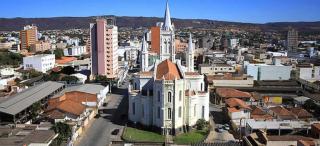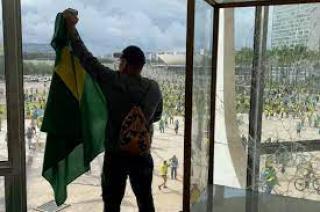Veja Também -
 Pessoas com TEA têm direito à cotas em concursos públicos
Pessoas com TEA têm direito à cotas em concursos públicos Governo de Minas fortalece o uso da linguagem simples
Governo de Minas fortalece o uso da linguagem simples Prefeitura de Montes Claros lança plataforma para emitir alvarás e agilizar construções na cidade
Prefeitura de Montes Claros lança plataforma para emitir alvarás e agilizar construções na cidade Minas Gerais entrega Medalha da Inconfidência a 171 personalidades e instituições
Minas Gerais entrega Medalha da Inconfidência a 171 personalidades e instituições Projeto 'Antes do Voto 2024' chega a Governador Valadares, Montes Claros e Uberlândia
Projeto 'Antes do Voto 2024' chega a Governador Valadares, Montes Claros e Uberlândia- Veja + Revelia News
Revelia News
Postado dia 20/01/2023 às 14:30:51
What’s Behind Riots in Brazil and Peru?

Brian Winter calls himself an optimist when it comes to Latin America. He’s covered the region for decades—these days, he’s editor of Americas Quarterly. But after the first few weeks of 2023, he says he’s struggling with that optimism. “I worry sometimes that I hear myself talk about the 2000s,” he said. “And it almost sounds like an aging rock band playing its greatest hits—waxing philosophical about when times were good.”
Back in the early 2000s, when Winter was living first in Argentina, then Brazil, people were talking about the “Latin American decade.” Local economies were buoyed by commodities prices, and local political races were getting more democratic. Now? He looks at the region and sees anti-government protests getting violent in both Peru and Brazil. In Chile, voters are duking it out over a new constitution. And polls reveal “democracy” is taking a beating.
If you’d told Winter two decades ago that hundreds of people would storm Brazil’s capital, entering Congress, the Supreme Court, and the presidential palace, the way they did on Jan. 8? He might not have believed you. “There had never been anything like it in Brazil’s long history,” Winter said.
To a lot of people, this moment felt eerily familiar: It just looked so much like the events of Jan. 6, 2021, at the U.S. Capitol. But the aftermath of this Brazilian riot could play out differently than it has stateside, as a new president tries to work levers of power that keep getting stuck.
As Latin America begins to feel more and more unstable, what’s the right way to cool things down? On Thursday’s episode of What Next, I spoke with Winter about how things could go in the region. Our conversation has been edited and condensed for clarity.
Mary Harris: To understand the distress that’s being felt across Latin America right now, I wonder if we could go back a little bit and explain Latin America’s phenomenal economic and political rise during the 2000s. You were living there during that time. People were talking about it as the “Latin American decade.”
Brian Winter: It was an intoxicating thing to be part of. I was living in Brazil from 2010 to 2015. 2010 was just the best year for Brazil. It was a year the economy grew more than 7 percent. It was Lula’s last year in office during his previous term. He had an approval rating upwards of 80 percent.
My favorite memory was flying all over Brazil, because on almost every flight you took, there were people on there who were flying for the first time. People who, because their lives had improved, were able to go by plane instead of by bus. You could often see who they were because they looked a little uncertain. They looked a little scared. That was just one little window into what was happening during those years, which was upward social mobility. And it was a product of two things. It was an era where there was a boom in commodities export prices for the things that Latin America sells to the world. A lot of that was driven by China. But there was another factor: A lot of these countries had made difficult reforms in the 1990s in order to stabilize their economies, open them up a little bit more to trade. And in the 2000s, they started to enjoy the dividends from that.
How did the wind come out of Latin America’s sails? How did the region make such a sharp turn?
Some of it had to do with things that were happening outside the region. The winds essentially changed. China’s economy started to slow down in around 2012, 2013. Commodities prices came down as a result. And therefore, virtually every country around the region went into a period of lower growth—and in some cases, such as Venezuela, Argentina, and Brazil, outright recession.
But, a big part of the story was that expectations rose so much during those good years. People were not only riding airplanes for the first time, but they were buying their first washing machines. They were buying big screen televisions. They were sending kids to private universities and public universities and other places for the first time. And when that started to slow down, a lot of people who had come out of poverty sensed what was happening. And they said, “I’m not going back.” They sensed that everything that they had gained was in danger. And that was what really pulled people onto the streets. That was the beginning of a lot of this social unrest, as well as the political instability, because people lost patience with their leaders very quickly when life stopped getting better.
You’re drawing this line between economic instability and political turmoil and how great expectations created an opening where people just would not have a return to the way things were.
And it exposed a lot of the challenges that the region has always had. Or maybe better put, during the good years, some of those things were papered over a bit, but then when the winds changed, it became clear that the old challenges—unsexy things like productivity, for example—came home to roost.
A recent article in the Journal of Democracy put it like this: “Latin America’s democracies are stuck.” Would you agree with that?
I think that there is an impatience and an unrest because these governments are not delivering what citizens want. They’re not meeting those expectations that were raised. There’s been a lot of coverage in recent years about Latin American governments swinging to the left, for example. And it’s true: More than 80 percent of the region’s citizens right now are governed by leaders who are left of center. But that ideological shift can disguise what’s really been happening, which is a vote against incumbents. It is really hard to be a president in Latin America right now. And what we see is people voting against whatever is there and preferring to cast their ballot instead for people that are new and people that offer something different. Incumbents or their preferred candidates in Latin America have lost 15 elections in a row now going back to 2018.
For president.
For president, that’s right. And so that really tells you the story. A lot of these people come in with these huge expectations. You may be familiar with Gabriel Boric, the president of Chile, who’s a millennial, 36 years old, swept to victory in 2019 with all this hope and youth. His approval rating today is 25 percent. And that is a story that keeps repeating itself over and over again across the region, because these economies just don’t grow. And more to the point, poverty is stuck. People’s lives are not improving. Inflation is high. COVID was brutal in the region. That’s another part of the story. And so for a lot of people, that manifests itself as being unhappy with their president. And in some countries, not all, they’re becoming unhappy with democracy itself.
I wonder if we can focus on Brazil and Peru as windows into very specifically how this discontent is playing out in a couple of places that are a little bit different. Brazil’s still picking up the pieces from Jan. 8. I wonder how you do pick up those pieces because you’ve had this moment of tremendous unrest. And it seems unclear to me how Lula pushes through and has a normal presidency at this point.
What we’re seeing happen now is he is moving somewhat cautiously because he has a big problem on his hands. And this is a really important difference with the United States. In Brazil, the loyalties of the military and of the police are very much in question. People might say, “Oh, well, a lot of police voted for Trump as well and supported Jan. 6.” There are degrees. And I would say that in the case of Brazil, it is a problem and could turn into a bigger problem.
I don’t think there’s any chance that the military will roll in and kick Lula out of office, for example. But there are lots of bad things that can happen in a country like Brazil that fall short of being a coup. If you don’t have command and control of your security forces, you will have all kinds of problems, including the one with the highway police, where, as an institution, they were trying to harass or stop Lula’s voters from going to the ballot box. That is a huge deal. The military is very connected in other parts of society as well. So not having their full buy-in can still generate instability.
Another country struggling right now is Peru, where violent protests have been going on for weeks, leaving at least 50 people dead.
Peru was another one of these countries that did really well by at least some measures in the 2000s. But as often happens, not all the progress was equally distributed. And in a lot of rural areas, malnutrition remains very high. Access to things like drinking water remains very low. And people felt like they were left out. And in a world of social media where everybody can see the good things that are happening, especially in capitals like Lima, that resentment has been simmering for years.
But there is an additional element in the case of Peru: This is a country that, by some measures, was the hardest hit in the world by COVID. The per capita death rate from Peru was higher than anywhere else, in part because of so many people being outside the system looking in. Even though Peru’s economy did well over the last 20 years, it’s still a country that has one of the largest percentages of informality—of people who live outside the formal economy. It’s the same old story. It’s people on the outside looking in and feeling like they weren’t included in the imperfect progress of recent years and who are now lashing out.
This anger was stoked after Peruvian President Pedro Castillo was unceremoniously ousted from power. Castillo had tried to dissolve Congress and rule by decree, which is an illegal step to consolidate power. So he go impeached and was arrested, and his vice president took over.
Castillo’s supporters were outraged. He’d been elected in 2021 on a platform of finally representing the rural and Indigenous communities that have felt left out of Peruvian politics for decades. But he took office as Peru’s sixth president in six years—and multiple predecessors had resigned or been impeached—so he didn’t necessarily have the odds in his favor
He just looked unprepared from Day One. He disappeared for several days after he was elected. He had meetings with his party trying to figure out what to do next. There were alleged acts of corruption involving members of his family. It’s true that he had a lot of the system against him, but he also didn’t do himself any favors. Finally, this all culminated in him trying this power play where he was going to launch a so-called self-coup, closing Congress, but Castillo didn’t have the support to do it. And hours after he announced that he was going to try to do this, he was in jail.
But then within a few days, there were protests in the street by people who thought this was unjust.
I’ve heard some Peruvian analysts say that the most popular thing that Castillo ever did was leave office because a lot of the people who were grumbling about him while he was there said, “What they”— they being the elite of the capital—“have done to him is unfair.” And so Castillo has enjoyed more support out of office than when he was in office.
It’s such an interesting dynamic where people are just pushing back against leadership in general. Right?
While a lot of Peruvians do not support Castillo and what he was trying to do in office, at the same time, he was a symbol—this schoolteacher from Camargo in the Andes being, in their view, pushed aside and thrown in jail unceremoniously by the political elite. To be clear, what Castillo did was illegal, period. It still really sat badly with a lot of Peruvians, especially in these communities where they saw some of themselves in him.
And so people came out on the streets. Then the police and military reacted in an incredibly and tragically heavy-handed way. That brings more people out onto the streets, as we’ve repeatedly seen throughout Latin American history. It just creates another one of these cycles of violence and political dysfunction that can become very hard to break out of once you’re in it.
You’ve noted that there are these boom and bust cycles in Latin America, politically and economically. So how do you think this moment is different from what you’ve seen before?
We’re going to go to the dark side of my thinking now. I’m an optimist and I don’t like to go here. But there’s been discussion about how the last decade in Latin America was a lost decade because the economies didn’t grow, because of all this political instability, corruption, scandals, and so on. Some people are worried that we could be in for another lost decade now in the 2020s. My concern is that maybe these economies are just flatlining and that when we talk about one lost decade or two, perhaps we’re not thinking hard enough about what’s really going on. The point being there is nothing that is clearly a driver of economic growth on the horizon. And without growth, it’s really hard to do things like reduce poverty and improve living standards. Because if the overall size of the pie is not growing, all you’re left with is to try to divvy it up in different ways. And some of that is necessary, but it’s not enough.
A lot of people have asked you what the U.S. role is here in a Latin America that’s struggling to find its footing. And you’ve said the most important thing for the U.S. to do is clean up our own act. We have our own struggles with democracy to tend to. And us telling Latin American countries what to do hasn’t been the best way forward in the past. Do you really think it’s going to be possible for the U.S. to stay out of Latin America’s domestic affairs? Because the more economic and political challenges Latin America faces, the more people are going to turn up on our Southern border. And of course, the border is a huge political football already.
There’s no question that these economic and political troubles in Latin America are driving people to leave. And the number of countries that are sending people to the United States has grown. It’s become a much more diverse group of countries, and that reflects how widespread some of these problems are. There’s this old tendency that you see, especially in Washington, where when something goes wrong in Latin America, people ask, “Well, what did the government in D.C. do wrong? What can they do differently?” And you raised this long history of U.S. intervention in Latin America. Especially in the 20th century, it manifested itself in ugly and often counterproductive ways. I think that now the Biden administration, especially, understands that these are sovereign countries and that the U.S. can only do so much.




